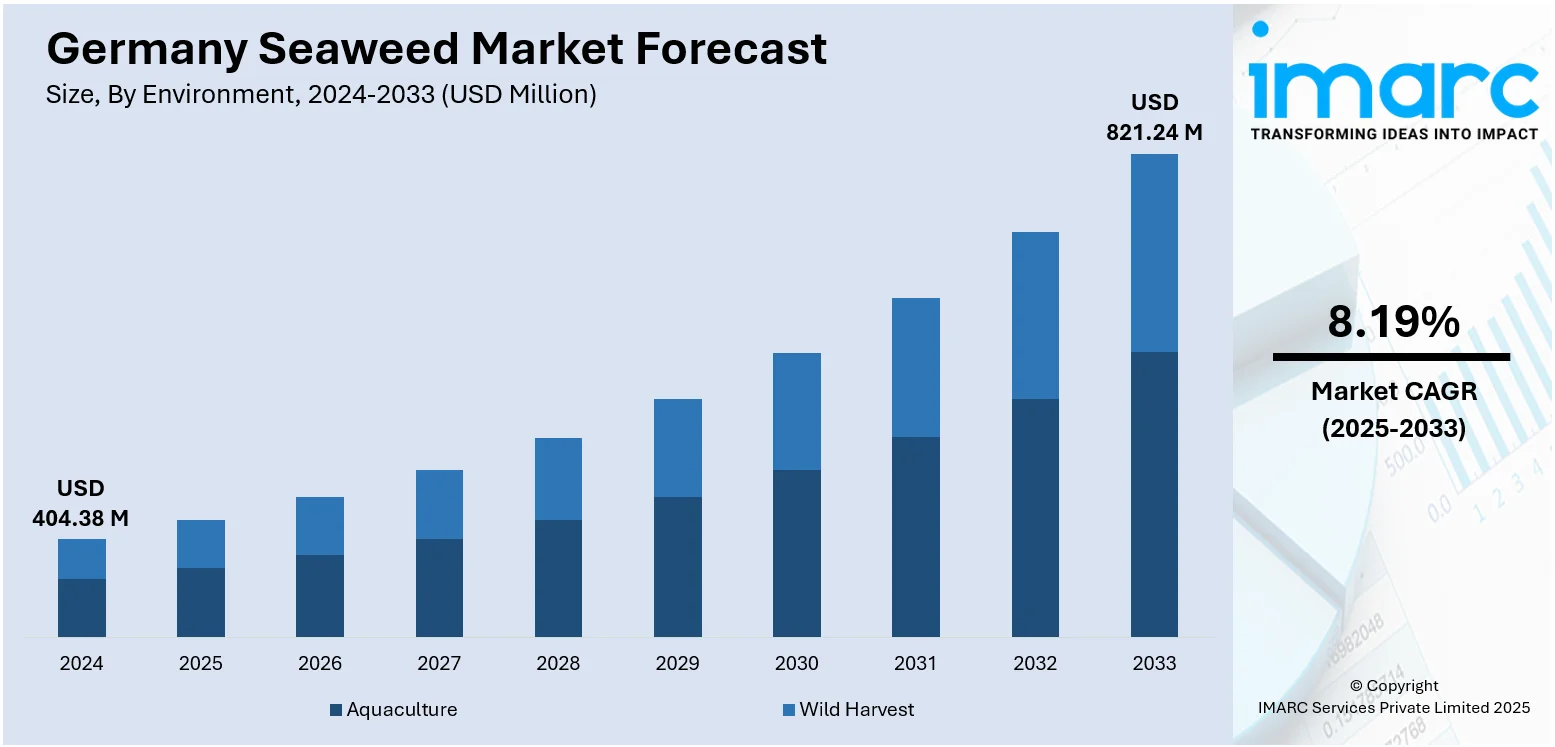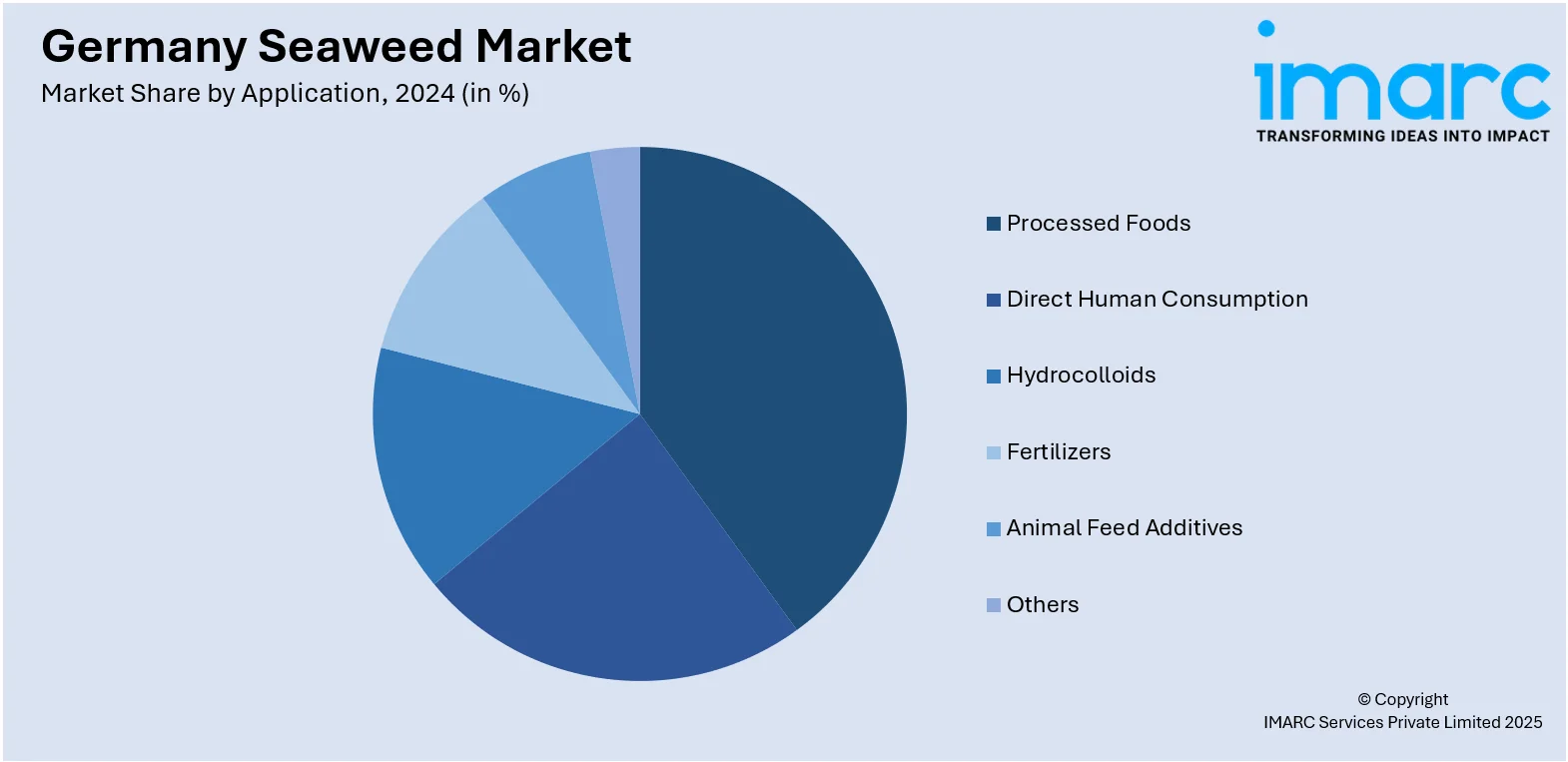
Germany Seaweed Market Size, Share, Trends and Forecast by Environment, Product, Application, and Region, 2025-2033
Germany Seaweed Market Overview:
The Germany seaweed market size reached USD 404.38 Million in 2024. Looking forward, IMARC Group expects the market to reach USD 821.24 Million by 2033, exhibiting a growth rate (CAGR) of 8.19% during 2025-2033. The market is driven by technological advancements in bio-based packaging solutions that align with Germany’s circular economy goals. To meet the rising demand for natural wellness products, nutraceutical companies are integrating seaweed extracts into health supplements and functional foods. Additionally, the incorporation of seaweed-derived biostimulants in organic farming is further augmenting the Germany seaweed market share.
|
Report Attribute
|
Key Statistics
|
|---|---|
|
Base Year
|
2024 |
|
Forecast Years
|
2025-2033
|
|
Historical Years
|
2019-2024
|
| Market Size in 2024 | USD 404.38 Million |
| Market Forecast in 2033 | USD 821.24 Million |
| Market Growth Rate 2025-2033 | 8.19% |
Germany Seaweed Market Trends:
Advancements in Bio-Based Packaging Solutions
Germany’s leadership in sustainable packaging innovation has positioned seaweed as a promising raw material for next-generation biodegradable alternatives. With mounting regulatory pressures to eliminate single-use plastics, material scientists and packaging manufacturers are exploring seaweed-based films and composites. Research institutions, particularly those associated with environmental engineering, are developing seaweed-derived polymers that meet European compostability standards. Pilot collaborations with major German retailers are testing seaweed films for food packaging, personal care products, and industrial wrappings. Government-supported innovation programs are channeling grants into projects aimed at commercializing marine biomass materials. Start-ups specializing in biomaterials increasingly feature seaweed as part of their product pipelines, and brand partnerships are positioning it within mainstream consumer markets. Sustainability certifications and traceability systems are under development to ensure compliant sourcing of marine biomass. As the German circular economy gains momentum, bio-based packaging derived from marine resources stands to become an integral part of mainstream sustainability strategies. These efforts directly contribute to Germany seaweed market growth.

To get more information on this market, Request Sample
Expanding Nutraceutical Sector and Health Awareness
Germany’s established position in the European nutraceutical sector is creating fertile ground for the incorporation of seaweed-based ingredients. Seaweed offers bioactive compounds that support health functions such as metabolism, immune regulation, and thyroid activity. Nutraceutical brands are increasingly turning to marine-derived extracts to formulate premium supplements, fortified foods, and functional beverages. With consumers favoring natural, plant-based products, seaweed’s profile as a sustainable marine superfood resonates strongly in domestic markets. Ingredient suppliers are scaling production capabilities to meet pharmaceutical-grade quality standards, ensuring compliance with stringent EU regulations. Research collaborations between marine biology institutes and nutraceutical companies are identifying the most bioactive seaweed species native to European waters for targeted applications. Marketing strategies emphasize traceability and ecological benefits, particularly appealing to Germany’s environmentally conscious consumer base. This demand is further driven by personalized nutrition trends, in which seaweed’s iodine content addresses specific dietary needs. As interest in functional wellness intensifies, seaweed-derived nutraceuticals are poised to gain a larger share in specialty food and pharmacy retail channels.
Role in Organic Agriculture and Regenerative Practices
Germany’s emphasis on sustainable farming practices and organic certification processes is stimulating interest in seaweed-based agricultural inputs. Biostimulants and soil enhancers derived from marine algae are increasingly recognized by German farmers for their ability to improve soil structure, increase nutrient uptake, and enhance crop resilience to climate variability. Organic certification bodies approve specific seaweed-based products, allowing their inclusion in certified farming systems. Partnerships between seaweed processors and agricultural supply cooperatives are facilitating distribution of these bioactive products to small and mid-sized farms. Research initiatives by agricultural universities are refining application guidelines to maximize productivity benefits, particularly for high-value crops and vineyards. Beyond crop cultivation, seaweed is being evaluated for methane-reducing livestock feed additives, aligning with Germany’s broader climate and sustainability targets. Regulatory alignment with European Common Agricultural Policy objectives ensures that bio-based agricultural products receive institutional support. As farmers increasingly prioritize regenerative agriculture techniques, seaweed-derived inputs are positioned as essential tools for improving productivity within sustainable frameworks.
Germany Seaweed Market Segmentation:
IMARC Group provides an analysis of the key trends in each segment of the market, along with forecasts at the country and regional levels for 2025-2033. Our report has categorized the market based on environment, product, and application.
Environment Insights:
- Aquaculture
- Wild Harvest
The report has provided a detailed breakup and analysis of the market based on the environment. This includes aquaculture and wild harvest.
Product Insights:
- Red
- Brown
- Green
The report has provided a detailed breakup and analysis of the market based on the product. This includes red, brown, and green.
Application Insights:

- Processed Foods
- Direct Human Consumption
- Hydrocolloids
- Fertilizers
- Animal Feed Additives
- Others
The report has provided a detailed breakup and analysis of the market based on the application. This includes processed foods, direct human consumption, hydrocolloids, fertilizers, animal feed additives, and others.
Regional Insights:
- Western Germany
- Southern Germany
- Eastern Germany
- Northern Germany
The report has also provided a comprehensive analysis of all major regional markets. This includes Western Germany, Southern Germany, Eastern Germany, and Northern Germany.
Competitive Landscape:
The market research report has also provided a comprehensive analysis of the competitive landscape. Competitive analysis such as market structure, key player positioning, top winning strategies, competitive dashboard, and company evaluation quadrant has been covered in the report. Also, detailed profiles of all major companies have been provided.
Germany Seaweed Market News:
- On March 31, 2025, Denmark and Germany advanced the AlgaeFood project, a EUR 1.9 million (USD 2.06 million) initiative promoting edible seaweed as a sustainable protein alternative, with 65% of the funding provided by European cohesion policy. Germany is participating alongside Denmark to build consumer awareness, strengthen education, and support the development of a full seaweed value chain. This project is relevant to Germany's seaweed market ambitions, particularly as it emphasizes low-impact production methods, nutritional benefits, and future scalability across Europe.
Germany Seaweed Market Report Coverage:
| Report Features | Details |
|---|---|
| Base Year of the Analysis | 2024 |
| Historical Period | 2019-2024 |
| Forecast Period | 2025-2033 |
| Units | Million USD |
| Scope of the Report |
Exploration of Historical Trends and Market Outlook, Industry Catalysts and Challenges, Segment-Wise Historical and Future Market Assessment:
|
| Environments Covered | Aquaculture, Wild Harvest |
| Products Covered | Red, Brown, Green |
| Applications Covered | Processed Foods, Direct Human Consumption, Hydrocolloids, Fertilizers, Animal Feed Additives, Others |
| Regions Covered | Western Germany, Southern Germany, Eastern Germany, Northern Germany |
| Customization Scope | 10% Free Customization |
| Post-Sale Analyst Support | 10-12 Weeks |
| Delivery Format | PDF and Excel through Email (We can also provide the editable version of the report in PPT/Word format on special request) |
Key Questions Answered in This Report:
- How has the Germany seaweed market performed so far and how will it perform in the coming years?
- What is the breakup of the Germany seaweed market on the basis of environment?
- What is the breakup of the Germany seaweed market on the basis of product?
- What is the breakup of the Germany seaweed market on the basis of application?
- What is the breakup of the Germany seaweed market on the basis of region?
- What are the various stages in the value chain of the Germany seaweed market?
- What are the key driving factors and challenges in the Germany seaweed market?
- What is the structure of the Germany seaweed market and who are the key players?
- What is the degree of competition in the Germany seaweed market?
Key Benefits for Stakeholders:
- IMARC’s industry report offers a comprehensive quantitative analysis of various market segments, historical and current market trends, market forecasts, and dynamics of the Germany seaweed market from 2019-2033.
- The research report provides the latest information on the market drivers, challenges, and opportunities in the Germany seaweed market.
- Porter's five forces analysis assist stakeholders in assessing the impact of new entrants, competitive rivalry, supplier power, buyer power, and the threat of substitution. It helps stakeholders to analyze the level of competition within the Germany seaweed industry and its attractiveness.
- Competitive landscape allows stakeholders to understand their competitive environment and provides an insight into the current positions of key players in the market.
Need more help?
- Speak to our experienced analysts for insights on the current market scenarios.
- Include additional segments and countries to customize the report as per your requirement.
- Gain an unparalleled competitive advantage in your domain by understanding how to utilize the report and positively impacting your operations and revenue.
- For further assistance, please connect with our analysts.
 Request Customization
Request Customization
 Speak to an Analyst
Speak to an Analyst
 Request Brochure
Request Brochure
 Inquire Before Buying
Inquire Before Buying




.webp)




.webp)












